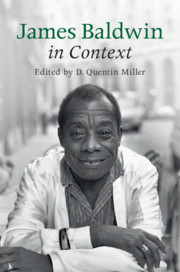Book contents
- James Baldwin in Context
- James Baldwin in Context
- Copyright page
- Contents
- Contributors
- Introduction: James Baldwin in Context
- Part 1 Life and Afterlife
- Part 2 Social and Cultural Contexts
- Chapter 12 Intersectionality
- Chapter 13 Baldwin and the Early Civil Rights Movement
- Chapter 14 Segregation and the South
- Chapter 15 The Assassinations: Medgar, Malcolm, and Martin
- Chapter 16 Gospel
- Chapter 17 “The Whole Body of the Sound”: The Black Musical Basis of Baldwin’s Literary Craft and Social Vision
- Chapter 18 Baldwin and Psychoanalysis
- Part 3 Literary Contexts
- Index
Chapter 15 - The Assassinations: Medgar, Malcolm, and Martin
from Part 2 - Social and Cultural Contexts
Published online by Cambridge University Press: 12 July 2019
- James Baldwin in Context
- James Baldwin in Context
- Copyright page
- Contents
- Contributors
- Introduction: James Baldwin in Context
- Part 1 Life and Afterlife
- Part 2 Social and Cultural Contexts
- Chapter 12 Intersectionality
- Chapter 13 Baldwin and the Early Civil Rights Movement
- Chapter 14 Segregation and the South
- Chapter 15 The Assassinations: Medgar, Malcolm, and Martin
- Chapter 16 Gospel
- Chapter 17 “The Whole Body of the Sound”: The Black Musical Basis of Baldwin’s Literary Craft and Social Vision
- Chapter 18 Baldwin and Psychoanalysis
- Part 3 Literary Contexts
- Index
Summary
Written at a nexus of national and personal turmoil, No Name in the Street (1972) and One Day When I was Lost: A Scenario Based on Alex Haley’s The Autobiography of Malcolm X (1972) reflect a precarious period for James Baldwin as author and public figure. Both works are most often regarded for the dramatic terms of their production and as evidence of Baldwin’s shifting political character. Such emphasis is not without reason. A mix of disorienting grief for lost friends, fledgling faith in his nation, and an urgent tone in step with emergent black radicalism marks each text. The uneasy amalgam of Baldwin’s signature resolve and growing despair denote personal anxieties regarding his place in the shifting black freedom struggle. At the turn of the decade, Baldwin found himself a survived civil rights icon facing an uncertain, though assuredly turbulent, future.
- Type
- Chapter
- Information
- James Baldwin in Context , pp. 157 - 168Publisher: Cambridge University PressPrint publication year: 2019

